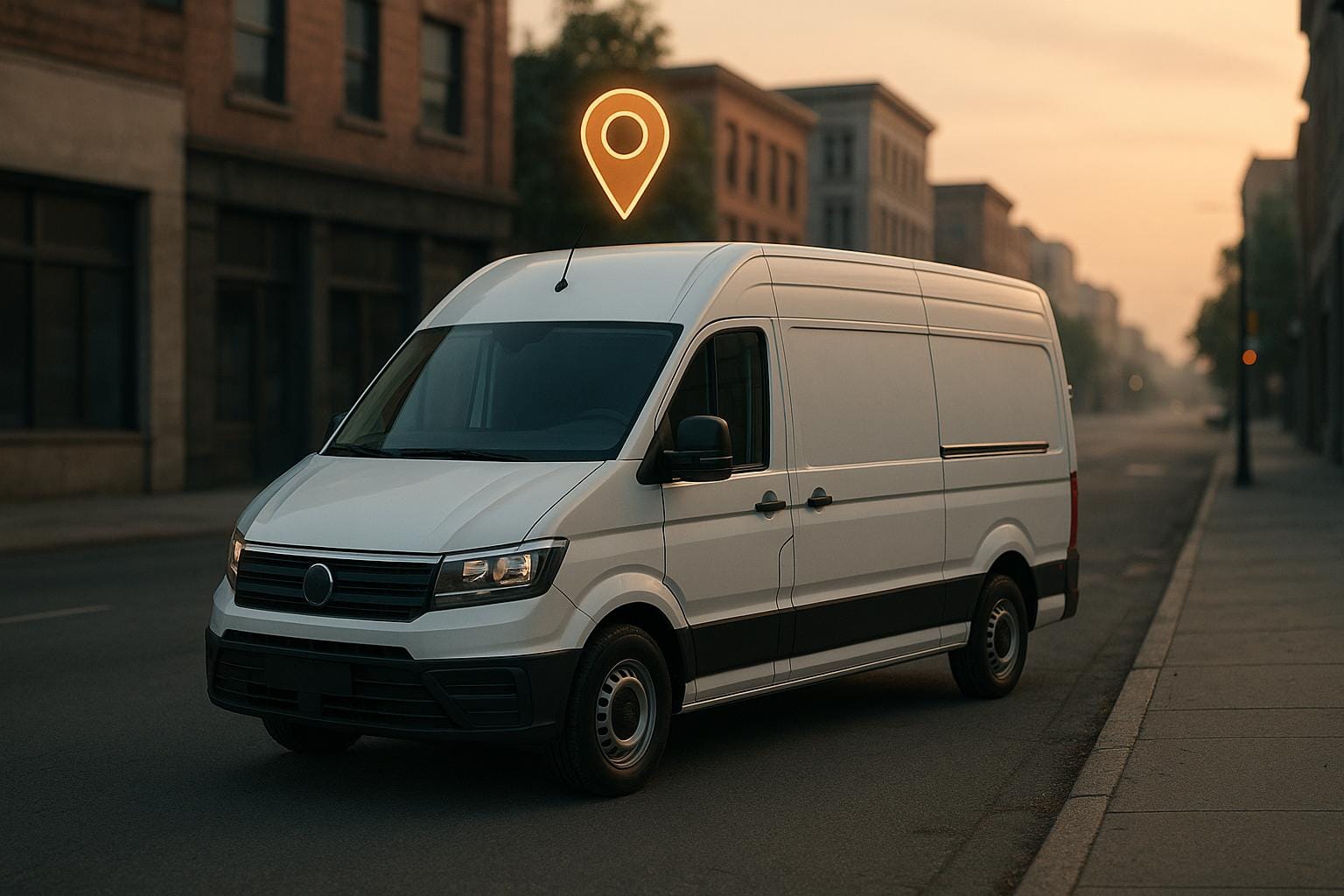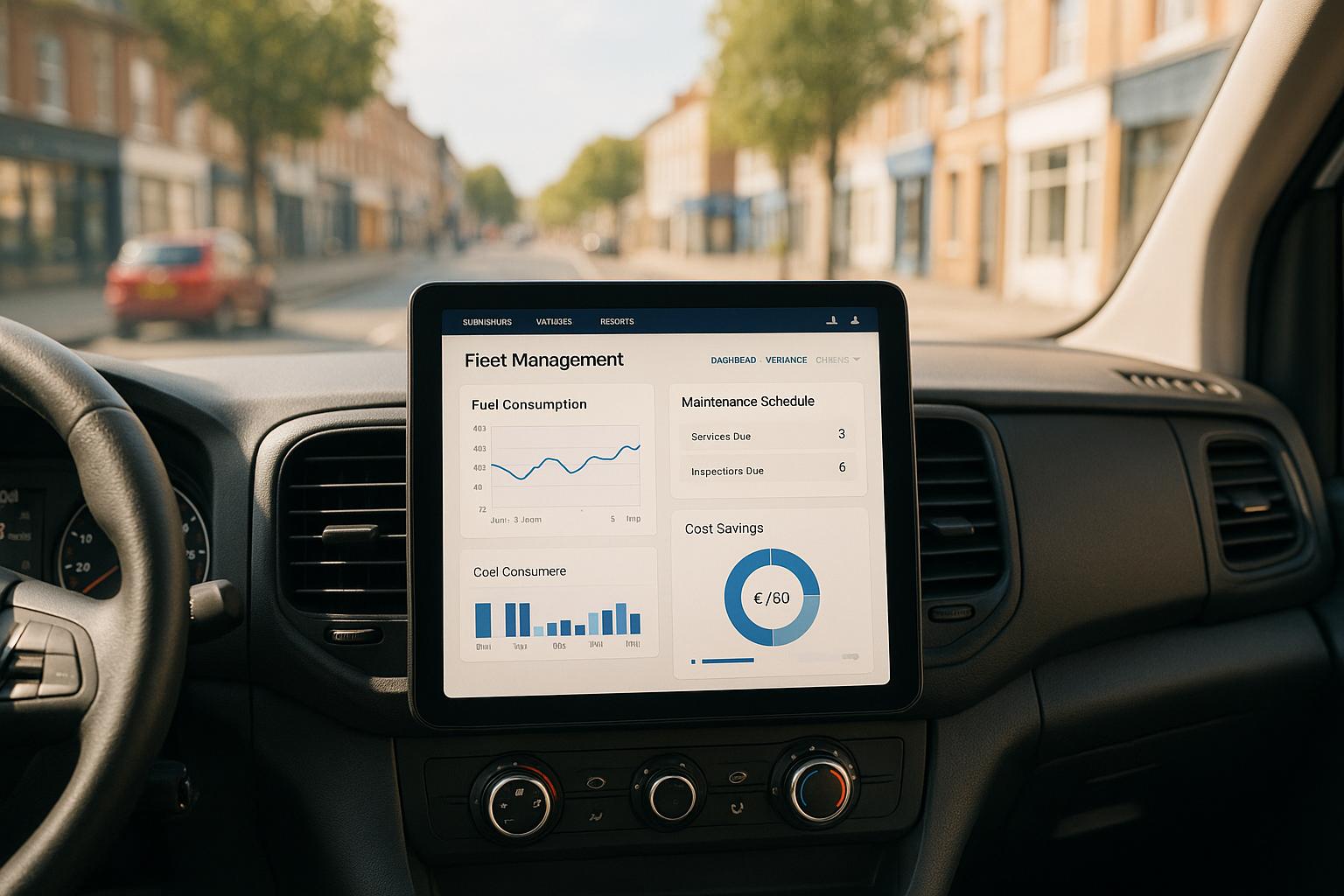Did you know? Over 130,000 vehicles were stolen in the UK in 2022, costing businesses millions in losses. GPS tracking can change that.
Here’s how GPS tracking helps recover stolen assets:
- Real-time tracking: Locate stolen vehicles or equipment instantly using satellite data.
- Geofencing alerts: Get notified when assets move outside designated areas.
- Police collaboration: Share precise location data with law enforcement for faster recovery.
- Prevent theft: Visible GPS systems deter criminals from targeting protected assets.
- Success stories: Businesses report over 90% recovery rates with GPS tracking.
GPS tracking not only improves recovery rates but also reduces financial losses and operational disruptions caused by theft. Whether you manage a small fleet or a large operation, these systems are indispensable for asset security.
Webinar | Advanced Stolen Vehicle Recovery Solution | Teltonika & 3Dtracking
How GPS Tracking Works for Asset Recovery
GPS tracking systems combine various technologies to detect theft and streamline recovery efforts. These systems rely on a network of tools to identify unauthorised activity, alert authorities, and provide precise location data to aid in retrieval. Let’s explore how features like real-time tracking and geofencing play a key role in ensuring quick recovery.
Real-Time Tracking and Geofencing
GPS trackers work by using satellite signals to pinpoint exact coordinates. This location data is then relayed through cellular networks to central monitoring systems, which fleet managers can access via computers or mobile devices. These systems boast an accuracy rate of up to 95%.
Geofencing adds another layer of security by allowing managers to set up virtual boundaries around important locations, such as depots, construction sites, or designated operational zones. If an asset crosses these boundaries, the system sends an immediate alert.
Rishi Mehra, vice president of product vision and experience at Trimble, highlights the importance of precise geofencing:
"A simple radius covers the roads leading to a facility, but can't differentiate whether a driver is in a yard or just approaching it. Precise geofences on entrances and exits provide more accurate real-life data."
This accuracy helps distinguish between normal vehicle activity and potential theft, enabling fleet managers to customise alerts for specific scenarios.
Alert Systems and Police Cooperation
When unauthorised movement is detected, GPS tracking systems send instant alerts through various channels, such as email, SMS, app notifications, or direct calls from monitoring centres. Many modern systems integrate with law enforcement databases, giving officers immediate access to critical information. For instance, 3Si's DirectToDispatch™ platform delivers live tracking data directly to police dispatchers, aiding in the recovery of assets worth over £120 million and contributing to more than 21,000 arrests.
The importance of swift police collaboration is widely acknowledged. The Verizon Connect Team explains:
"The near real-time alerts delivered from a GPS tracker for equipment allow fleet managers to notify the police of unauthorised use or suspicious movement as soon as possible - speeding up stolen asset recovery."
Additionally, some monitoring services employ former law enforcement professionals to enhance recovery efforts. DIGITPOL, for example, works closely with police to ensure an effective and coordinated response.
Recovery Operations Using GPS Data
Once an alert is confirmed, GPS data becomes the cornerstone of recovery operations. Real-time updates and historical route information help turn recovery into a proactive effort. Data such as location history, speed, and travel routes can also support law enforcement in identifying patterns, accomplices, and building a strong case for prosecution.
Advanced systems, like Covert by 3Si, combine multiple technologies - GPS/GNSS, cellular, Wi-Fi, and RF - to ensure tracking devices continue to function even in low-signal environments. This redundancy is crucial when thieves attempt to evade detection by moving assets into areas with poor connectivity.
For example, STL Design and Build shared their experience with One Step GPS:
"One Step assisted in the recovery of one of our vehicles that was stolen during overnight hours... One Step found the location of the vehicle within minutes, so we could notify the authorities, and retrieve the vehicle 5 minutes after."
Advanced GPS Features That Improve Recovery Success
Modern GPS tracking systems have taken asset recovery to the next level by incorporating multiple layers of security.
Dual-Tracker Technology: A Backup Plan That Works
Dual-tracker technology ensures uninterrupted monitoring by pairing a primary tracker with a backup device. If the main tracker is disabled, damaged, or removed, the backup immediately takes over and sends an alert. This setup often combines cellular and satellite networks for connectivity in areas with poor GSM coverage, while dual-frequency GPS (using L1 and L5 bands) adds extra resistance to jamming attempts.
Take Guatemala, for example. A vehicle leasing company there successfully used Teltonika FMC130 devices as primary trackers and TAT140 units as backups. This approach not only improved their recovery rates but also encouraged them to expand into new markets, including construction site monitoring. To maximise effectiveness, both devices were installed in concealed locations, with the backup configured to periodically check the status of the primary tracker. GRS Fleet Telematics has also adopted this dual-tracker strategy in their Enhanced and Ultimate packages, achieving an impressive 91% recovery rate for stolen vehicles.
Remote Engine Shutdown: Taking Control of the Situation
Remote engine shutdown takes GPS tracking a step further by actively helping to prevent theft. This feature allows authorised users to disable a vehicle's engine remotely, ensuring it can't be moved any farther. Instead of abruptly cutting power, the system gradually reduces the fuel supply, bringing the vehicle to a safe, controlled stop. Shutdowns are only executed under safe conditions, such as when the vehicle is stationary or within a predefined safe zone.
The significance of this feature becomes clear when looking at theft statistics. Between 2015 and 2018, 92,000 rental cars were stolen in Texas, and over half were never recovered. Remote shutdown systems, combined with real-time alerts and the ability to reactivate the vehicle immediately if needed, enhance both safety and recovery success during these operations.
Tailored Solutions for Fleets of All Sizes
Advanced GPS tracking systems can be customised to meet the unique needs of fleets, whether small, medium, or large.
- Small fleets (1–10 vehicles): Real-time tracking, geofencing, and basic driver behaviour monitoring are typically sufficient.
- Medium fleets (10–50 vehicles): These fleets benefit from features like route optimisation, detailed driver behaviour analysis, and enhanced security measures such as dual-tracker technology.
- Large fleets (50+ vehicles): Advanced tools like artificial intelligence and machine learning come into play, offering predictive insights, detailed reporting, and seamless integration with existing fleet management systems.
The advantages of customisation are clear in real-world feedback:
"We've drastically increased safety, thanks to improved driver feedback. Previously we had up to 40 violations per month. We've brought it down to 1 or 2."
Customisation might involve tweaking geofence sensitivity, setting alert thresholds, or adjusting reporting schedules to align with specific operational needs. With over 75% of fleet managers now relying on telematics for daily operations, tailored GPS solutions have become essential for boosting recovery rates and improving overall fleet efficiency. These advanced tools are paving the way for even better security practices in the future.
Best Practices for Fleet Operators Using GPS Tracking
Making the most of your GPS tracking system involves more than simply installing the devices and hoping for good results. Fleet operators who implement well-thought-out strategies often experience better outcomes, particularly in preventing theft and recovering assets.
Where to Install Tracking Devices
The placement of tracking devices is key to their effectiveness. For hardwired units, positioning them under the dashboard near the fuse box with a constant power source is ideal. Plug-in devices, often placed in OBD ports, can be more exposed, so consider their vulnerability. Portable trackers offer flexibility and can be hidden in places like the glove compartment, under seats, or on other inconspicuous flat surfaces. Regardless of the type, always check the signal strength and ensure the device is securely mounted using double-sided tape or zip ties. Avoid locations where metal, cables, heat, or moving parts could interfere with performance. If installing devices on the vehicle's exterior, opt for weatherproof models specifically designed to endure outdoor conditions.
Once your devices are in place, the next step is ensuring your team is ready to act on the data and alerts these trackers provide.
Staff Training and Theft Response Plans
Proper training equips your team to use the GPS system effectively and reinforces good security habits. Training sessions should highlight best practices, such as locking vehicles and parking in well-lit areas. Additionally, it’s important to establish a clear, written GPS tracking policy. This policy should explain why tracking is being used, how the data will be utilised, and what measures are in place to protect privacy. This level of transparency builds trust and ensures everyone understands their role in keeping vehicles secure.
Theft response plans are another crucial element. These plans shouldn’t just sit on paper - they should be practised regularly. Staff need to know exactly who to contact when an alert is triggered, what details to provide law enforcement, and how to collaborate with your GPS tracking provider’s recovery team. Regular refresher training and updates on new features or procedures help maintain a high level of readiness.
While training and preparation are essential, it’s equally important to stay compliant with legal requirements.
Following Data Privacy Laws
Under UK law, including GDPR and the Data Protection Act 2018, tracking must be transparent and consensual. Inform employees when vehicles are being tracked, use the data strictly for security purposes, and implement strong safeguards to protect it. Define clear data retention periods and perform regular audits to ensure compliance. The Human Rights Act also requires that monitoring be both proportionate and necessary. This means tracking should be limited to essential purposes and restricted to working hours for company vehicles.
Additionally, the use of GPS-jamming devices is illegal in the UK. To counteract this, tracking systems should incorporate anti-jamming features rather than attempting to block signals. GRS Fleet Telematics adheres to these legal standards by employing stringent data management practices and comprehensive tracking policies, ensuring both operational effectiveness and trust while boosting the chances of asset recovery success.
Conclusion: GPS Tracking Results for Asset Recovery
GPS tracking has proven to be a game-changer for fleet operators dealing with the ever-present risk of vehicle theft. With over 1.2 million vehicles stolen annually in the US alone - and nearly half never recovered - the stakes are equally high for UK businesses managing valuable fleet assets. This highlights the pressing need for stronger security measures.
The financial toll of theft goes well beyond the initial loss of a vehicle. For example, construction equipment theft costs exceed £1 billion annually, with traditional recovery rates sitting below 20%. Yet, companies adopting GPS tracking systems report recovery rates exceeding 90%, turning what could be a devastating loss into a manageable situation.
The real-world impact speaks volumes. In one case, a logistics company equipped with GPS tracking recovered a stolen delivery truck and saw two suspects arrested - all within 45 minutes of the theft.
But theft recovery is just one piece of the puzzle. GPS tracking also offers operational perks that make the investment worthwhile. Fleet operators have reported lower fuel costs and fewer accidents. These benefits stem from improved driver behaviour monitoring, optimised routes, and reduced idle times - advantages that continue to pay off long after the system is installed.
Key Points for Fleet Operators
To maximise the benefits of GPS tracking, fleet operators should focus on strategic implementation. This includes carefully placing tracking devices to avoid interference, choosing between hardwired or portable units based on their needs, and ensuring staff are well-trained in theft response protocols.
Compliance with UK data protection laws is equally critical. Transparent policies, employee consent, and proportionate monitoring practices safeguard both the business and its workforce. GRS Fleet Telematics, for instance, adheres to these regulations while offering a 91% recovery rate for stolen vehicles. Their dual-tracker technology, combined with 24/7 recovery support, starts at just £7.99 per month.
Advanced features like geofencing alerts, remote engine shutdown, and collaboration with law enforcement add extra layers of security. Immediate notifications enable swift action during a theft, while backup tracking systems ensure that criminals can't simply disable a single device to avoid detection. When paired with proper training and implementation, this multi-layered approach transforms GPS tracking into a robust asset protection strategy - delivering tangible results for UK fleet operators.
FAQs
How does geofencing enhance fleet security compared to traditional methods?
Geofencing brings a cutting-edge solution to fleet security, offering real-time monitoring and instant alerts. By setting up virtual perimeters around specific areas, fleet managers can receive immediate notifications if a vehicle enters or exits these zones. This enables swift action against unauthorised movements, helping to minimise the risks of theft or improper use.
Beyond bolstering security, geofencing ensures drivers stay within designated routes and operational zones, aiding compliance with safety guidelines. It also allows fleet managers to track vehicle activity and driver behaviour, improving efficiency and enabling prompt interventions when necessary. This technology offers a smart, cost-efficient way to safeguard assets while streamlining fleet management.
What legal requirements should UK businesses consider when using GPS tracking for their fleet?
GPS Tracking and Data Protection Laws in the UK
In the UK, businesses using GPS tracking for their fleets must adhere to data protection laws, with the General Data Protection Regulation (GDPR) being a key focus. Employers are obligated to inform employees about the tracking system, explain its purpose, and clarify how the collected data will be used. Gaining employee consent is a crucial step before introducing any tracking measures.
To remain compliant, businesses should create a transparent policy that clearly outlines how GPS devices will be used. This policy should emphasise respect for employee privacy and ensure that any data collected is relevant, proportionate, and strictly limited to its intended purpose. Proper management of employee information is not just about meeting legal requirements - it also helps build trust and avoid potential legal complications.
How can fleet operators keep GPS tracking systems effective in areas with weak signal coverage?
To keep GPS tracking systems reliable in areas with weak signal coverage, fleet operators can implement a few smart strategies. One effective approach is using trackers that work with multiple satellite systems, such as GLONASS or Galileo. These systems can boost signal reliability and accuracy, especially in tricky locations like remote regions or urban areas with towering buildings.
Another option is to invest in dual-tracker technology, which combines GPS with alternative tracking methods for stronger connectivity. Regularly updating software and performing routine maintenance checks are also crucial steps to maintain optimal performance and minimise signal issues. By following these practices, fleet operators can maintain dependable tracking, even in challenging signal conditions.




